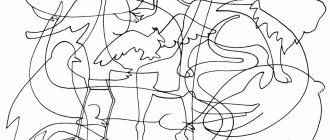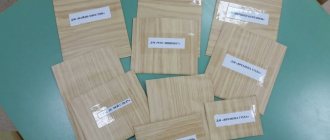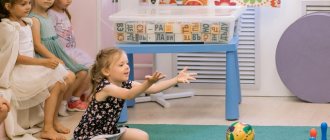Physical development of the child
The main goal is to make the child stronger, more resilient, dexterous, and teach him to coordinate his movements well. Experts recommend doing the following exercises daily:
- stepping over small obstacles;
- walking on an inclined plane;
- jumping over a drawn line (like playing hopscotch);
- walking on a string placed on the floor;
- jumping forward on both legs;
- jumping from low heights.
It is very useful for three-year-old children to swim, dance, play various ball games, ride a bicycle, and perform various exercises on the children's sports wall. Be sure to teach your child to do morning exercises or do fitness with him.
Smart Grow. Drawing & Coloring
Drawing application for children from 3 years old. The child is offered a choice of about 20 characters, which can be painted to your taste and color. All details of the picture are very large, which corresponds to the age marking of the application.
You can choose not only animals, but also transport - a car, a hot air balloon and a submarine. After the child colors the picture, you can bring it to life: funny music plays on the screen, and you can play with the hero.
The program interface is very simple, so even a three-year-old child can easily understand it.
Intellectual and creative development
At three years old, a child actively learns about surrounding objects and phenomena, explores his capabilities, and for this it is necessary to develop attention, logical thinking, memory, and imagination. What exercises will help?
- Search for the desired color by sample or name.
- Collecting nesting dolls, pyramids, molds of different sizes.
- Selection of volumetric and flat squares, circles, triangles and other geometric shapes.
- Games for the difference between the concepts of “small”, “large”, “medium”.
- Folding a picture-riddle: first from 2 two parts, then from 3-4 parts.
- Search for a whole picture by its piece.
- Generalization of objects according to the main characteristic: living-non-living, edible-inedible, etc.
- Game of mosaic, lotto, dominoes.
- Finding matches, for example, shadows and figures.
- Searching for an extra item in a group of other items.
- Adding missing details.
- Reading fairy tales together. If the child knows some letters, ask them to find them in the text.
Take every opportunity to teach your baby something new. For example, during a walk, tell him about trees, animals, phenomena, transport - in a word, about everything that you came across along the way.
The study of elementary mathematical concepts and numbers should take place in a playful way. Ensure that your child not only memorizes the names of numbers, but learns how to determine the number of objects.
To develop creative thinking, experts advise regularly performing the following exercises :
- playing with a construction set, cubes, creating structures based on a model;
- collecting simple puzzles;
- drawing and coloring with paints, pencils, felt-tip pens;
- drawing a variety of geometric shapes, you can use a stencil or pattern;
- modeling simple figures from plasticine, salt dough, clay;
- applications made from natural materials, colored paper and cardboard, magazine clippings;
- cutting along the contour with scissors, etc.
Children aged 3 enjoy playing story games, puppet theater, and participating in simple short dramatizations.
EXAMPLES OF FINGER GAMES
So, the development of fine motor skills in children 3–4 years old begins with the simplest games:
- Actively rub your palms and ask your baby to do the same.
- Show your child how siblings greet each other - the fingers of the same name on your hands: touch each other alternately with your little fingers, ring fingers, middle fingers, index fingers and thumbs, telling your baby that this is how brothers greet each other. Let him try again.
- Let the baby imagine that his index and middle fingers are legs that are stomping along a path (for example, into the forest for sweet strawberries). His fingers should precisely walk along the surface of the table.
- And now let him turn into an old grandmother (grandfather) who cannot see well. The doctor prescribed glasses for them (the child uses his thumb and index fingers to pretend to be glasses, bringing them to his eyes).
A little later, when the baby gets used to such exercises, you can start playing with short rhymes, gradually adding longer rhymes and complex movements.
- boat
A hare is swimming in a boat (the child folds his hands in the shape of a boat),
The little bunny calls to swim with him (the baby waves his hands with inviting gestures).
- cat
How painfully does a baby cat bite?
He decided that he saw not a finger, but a mouse!
But I'm playing with you, baby,
And if you start biting, I’ll say: “Come on, shoot!”
When performing this game, the mother takes an old clothespin with a relaxed clamping mechanism so that it does not catch painfully, and “bites” each of the child’s fingers in turn.
- Curlers
The essence of this game is to bend each finger on the baby's hand in turn. To do this, you can use a variety of nursery rhymes. For example, these:
This finger is daddy.
This finger is mommy.
This one here is a grandpa.
This is grandma.
Well, this finger is me.
That's my whole family!
(You need to start counting with your thumb to finish with your little finger)
This brother found a fungus.
It began to cut him.
It was my brother who was frying a mushroom.
This one just ate and ate,
Look how fat he has become!
(Counting, on the contrary, starts with the little finger and ends with the thumb).
Speech development
Normally, a three-year-old child speaks about 1000 words well and can already speak well, so special attention should be paid to speech development. What can you do?
- Communicate with your child as much as possible, be interested in what he says.
- Perform articulation exercises daily. This will help you place the speech sounds correctly.
- Discuss the story pictures. A collection of fairy tales by Vladimir Suteev is ideal for classes.
- Learn poems and songs. Poetic riddles are a hit with kids.
Speech development is positively influenced by games and exercises that involve fine motor skills , for example:
- all kinds of games with cereals, beans, buttons, sand, shells, pasta, etc.;
- fastening buttons, lacing;
- finger gymnastics;
- origami;
- games with water.
Musical activities help develop speech hearing: singing, guessing familiar sounds, playing musical instruments, guessing songs, singing vowel sounds.
Speech
What should a child learn?
- Sentences must be at least 5-6 words.
- The child must be able to name his personal information.
- Clearly distinguishing the characteristics of an object.
- Knowledge of several actions (walks, cries, talks, meows, etc.).
Speech lesson in front of a mirror
If you practice at home, prepare cubes or cards with letters so that your baby continues to form words from them. Remember that three-year-old children still do not have very well developed memory, so do not ask your child to spell out complex words or repeat long sentences
Social development
The development of social skills is especially important if the child does not go to kindergarten for some reason. To do this, encourage play and communication with other kids on the playground in the yard. In addition, teach your baby to be independent:
- give feasible tasks, for example, making the bed, putting away a toy, washing a plate after yourself;
- ask for help when you cook or clean;
- teach how to dress and undress, fasten shoes, neatly fold things;
- introduce the rules of behavior at the table, on the street, in a public place, at a party, etc.
- teach polite words: thank you, please, etc.
Night terrors: why they happen and what to do about them
What are nightmares
Nightmares are sleep disturbances in which a child may suddenly cry, scream, moan, or mutter in bed with eyes wide open but not awake. Because she is stuck in a sort of twilight zone between sleep and wakefulness, she is unaware of your presence and is unlikely to respond to anything you say or do. The episode lasts anywhere from two to 40 minutes, and when it ends, your child suddenly goes back to sleep with no memory of the incident.
How are nightmares different from night terrors?
Sixtine fights a monster in her bedroom in Laure Fauvel's “Terreurs”, 2014, in Paris, France.
An imaginative photographer has brought to life monsters that haunt children's nightmares. Armed with sticks, wands and swords the eight and nine year-olds appear to be getting the upper-hand against the villains. Parisian photographer Laure Fauvel, 22, said: I wanted the children not to be victims and to fight the monsters. (Photo by Laure Fauvel/Barcroft Media) Unlike a night terror, a nightmare leaves your child truly awake—she can remember the dream and sometimes talk about it. In addition, children have nightmares during sleep, often in the early morning hours between 2 and 6 am. On the other hand, they usually experience night terrors in the first few hours of the night during deep, dreamless sleep.
The easiest way to tell the difference between a night terror and a nightmare is to ask yourself who is more upset that morning. If your child is more agitated, he had a nightmare. If you're the one who's concerned, she probably had a night terror. The “horror” lasts much longer for the parent who observed it than for the child who experienced it.
What causes nightmares and can they be prevented?
There is no definitive way to prevent nightmares because no one knows for sure what causes them. Nightmares can occur due to erratic or inadequate sleep patterns or any type of sleep deprivation. They are caused by stress during the day or excessive fatigue. What will be known is that, by themselves, nightmares do not mean the child has a psychological problem.
Addressing any other sleep problems your child has (such as getting up in the middle of the night) and ensuring they have regular, calming bedtimes and get enough hours of sleep can help prevent night terrors. In some cases, nightmares are caused by sleep apnea, a serious but treatable disorder in which enlarged tonsils and adenoids (normal tissue in the throat) block the airway during sleep, making breathing difficult and causing the child to become partially awake.
How to exercise at home?
The developmental lesson should take place in suitable conditions: in good lighting, in a ventilated room. The TV and computer need to be turned off, toys should be put away so that nothing distracts the baby. Make sure your child has had a good night's sleep, is not tired, and is not hungry or thirsty. Try to have your classes regularly, at the same time, because three-year-olds are very sensitive to changes in routine.
If a child refuses to complete the proposed tasks, do not force him, occupy him with something else. After some time, try again, most likely it will be successful.
A moment of creativity
There are many ways to entertain your baby at home. The following options will appeal to creative children. They require perseverance and help from parents. You can offer your little one the following activities:
- Make something from scrap materials.
Every housewife will find some cereals, coffee beans and other things at home. All this will come in handy. You also need PVA glue and imagination.
You can make a vase from the prepared materials. For this you need a glass bottle with a wide neck or a glass. The container is greased with glue from the outside, then cereals, grains and everything that has been prepared are carefully poured onto its surface. You can make patterns on the vase.
- Many children love cutting paper. So why not turn it into a fun activity. The baby can be given the opportunity to cut out everything he likes from the provided magazines and pictures and paste it on his poster.
It is worth paying attention to the choice of scissors. They should have rounded ends so that the baby does not get hurt.
- In addition to cutting out ready-made pictures, you can give your baby the opportunity to make an applique on their own from colored cardboard and paper. Of course, he can’t cope without the help of his parents, but what an interesting activity this is that can unite the whole family.
Crisis of three years
The three-year crisis is considered the most turbulent in a child’s development, and it is a serious obstacle to regular developmental activities. Negativism, hysterics, stubbornness, ignoring requests, jealousy - you can encounter all this at any time. What to do in this case?
- Change your tactics and ignore the hysteria.
- Give your child more time to recover.
- Provide choice, or the illusion of it.
- Instead of forcing your child, offer help.
- Don't criticize or scold.
If you feel that you cannot cope with yourself and your child, seek the help of child psychologists and early development teachers. Most likely, in an unfamiliar environment the child will begin to behave more calmly. Classes in early development centers are held in small groups of up to 6 people, where children feel comfortable and receive a lot of attention.
Date of publication: 09/24/2018. Last modified: 01/13/2020.
THE IMPORTANCE OF FINE MOTOR SKILLS
Fine motor skills of the hands are a unity of coordinated manipulations that are aimed at performing small precise movements with the hands and fingers. Just a few decades ago, parents did not have problems with the motor skills of their children. After all, the children did a lot of things with their own hands: they helped peel vegetables, make pies, do laundry, sort out cereals, tie shoelaces and fasten buttons. Today, most of these activities are done either by adults, allowing children to play, or by specialized machines. Even Velcro shoes and clothes with zippers deprive the child of the opportunity to practice the fine movements of his fingers.
Meanwhile, a lot says about the importance of fine motor skills. Children with weak motor skills are not ready for writing and often lag behind in speech development. All this affects school performance and leads to increased stress on the child’s nervous system.
Among other things, the state of fine motor skills of the hands directly affects the development of the child:
- self-care skills;
- perseverance;
- thinking;
- attention;
- imagination;
- vocabulary;
- memory.
After all, the centers of the cerebral cortex responsible for fine motor skills are adjacent and closely interconnected with the centers responsible for the development of these areas. By activating the fine motor area, we naturally influence the neighboring ones.
Learning letters is fun for kids!
An educational application for preschoolers with which you can learn the alphabet. The main advantage is that after completing the letters, he offers to consolidate knowledge through games.
The child will look for objects starting with a certain letter, color “smart” pictures, and also read funny rhymes that will better help memorize letters.
The developers recommend using this application from 4 years of age. According to reviews, mothers are very pleased with this program.
Rating of the best educational toys for children over 3 years old
- Set of business boards “Favorite Fairy Tale”. Seven panels in the form of fairy-tale characters will teach children to read, count, fasten buttons, etc.
- Educational panel "Seasons". On a decorative tree you can attach “leaves” in the form of seasons: a snowflake, a flower, a green and red leaf.
- Landscape table "Road Rules". Using bright details and mobile cars, he teaches kids the basics of traffic rules.
- Bee Logo Robot Set. By moving the bees with the help of arrows, kids learn the directions: “right,” “left,” “forward” and “backward.”
- Game set “Kingdom of Numbers”. As kids build the town, they count its towers, columns, natural resources, animals, etc.
- Wall panel "Mega blocks". A large mosaic with bright details that are assembled directly on the wall.
Personal care
Hygiene. For easy access to the sink, we placed a stool and hung a faucet extension. A towel, toilet paper, a basin for dirty clothes - everything is at the child’s level. He uses an adult soap dispenser: he presses with one hand, and places the other palm towards the hole from which soap drips.
During training, I reorganized the storage:
- she laid out combs, elastic bands, beads, bracelets and hairpins in different baskets;
- added teeth cleaning supplies;
- My husband and I hung a lower mirror.
Now if there is silence at home, we understand that the child is in the bathroom.
Dressing yourself. I myself really love order and teach my child to do it. My daughter puts her things back in their place, sometimes we have to remind them or do it together. It is clear that her independence and self-confidence are directly related to the fact that the necessary things are always available.
In the hallway I hung hooks for outerwear and a backpack. Opposite on the shelves in the closet I placed a basket with hats and mittens. Underneath it are stored outdoor toys and a bucket with a sponge and cloth for washing shoes. At the entrance there is a shelf with shoes for the weather, the rest is stored in the nightstand, just like ours.
I organized the wardrobe and hallway areas during the course for children under 3 years old, now I’ve just made small changes to make it even more convenient for my daughter. For example, I added the Trugen stool from Ikea. Dressing on it is clearly better than just on the floor or on an adult sofa, where your feet don’t reach the floor. True, now my daughter also uses it as a ladder to climb onto the sofa.
Children's clothes are stored on hangers and in the chest of drawers. I tried to place things so that they were as visible as possible. The chest of drawers is divided into sections to make it easy to maintain order.
Mathematics
My daughter understands quantity, knows numbers. We count the apples in the store, the number of people in the family and the days in the week. I have prepared materials for comparing quantities and symbols, and I plan to continue the lessons in the future - I see that the child does it with pleasure.
Grandma also has numbers and round circles on magnets. Recently we came to visit them, I attached the numbers to the refrigerator: to number 1 - one round piece, to number 2 - two round pieces. She put the rest in a bowl, and Julia herself attached them to the numbers.
Using the clock puzzle, the child learned to count and understand that numbers can express quantity and order. In the living room there is a clock with hands, and opposite it there is an electronic clock with numbers. Already going to compare the values, but so far only 12 is unmistakably obtained
Using this set we study the numerical meaning of numbers. Next to each number is the number of items.
Easy Music – Give kids an ear for music
Parents whose children are partial to music and dancing should pay attention to this application. It is known that rhythm and ear for music need to be learned from early childhood, but it is not always possible to show the child all the musical instruments.
This can be done using interactive applications. The description states that the application is created for children aged 5 years and older, but in fact, it is also suitable for three-year-olds.
Children learn to recognize notes, tone, rhythm and melody in a nature-inspired play environment. In the application you can not only listen, but also create your own musical masterpieces. And, of course, we cannot ignore the design of the application - the illustrations are simply gorgeous.
Learning colors is fun!
This is another application from the developers of ARAMAIS AYRAPETYAN, who make educational electronic aids for children. By analogy with the application where you need to learn letters, here the child learns all the primary colors in a game format.
The child is helped in this by gnomes who offer the user not only to learn all the colors of the rainbow, but also to mix paints, find identical objects, and also listen to funny rhymes about colors.
By the way, you can safely download such an application to your phone or tablet before traveling by plane. It does not require the Internet, and the plot of the game is so exciting that it will help your child endure any, even the most boring and long flight.
Montessori Numberland
Maria Montessori's methods of child development have finally been adapted for gadgets. In this particular application, the developers have created tasks for teaching counting to children aged 3 years and older.
Numbers are introduced gradually: if at first the child simply learns to write and recognize numbers in a picture, then by the end of training he will already be able to count and solve simple logic problems.
The application is completely safe for children, as it is closed from advertising. Despite the scientific approach, the program is not without bright animation and funny children's stories.






